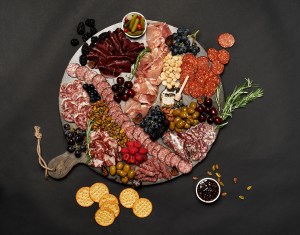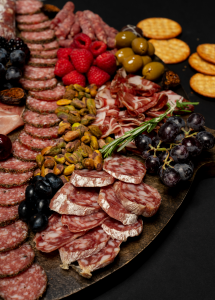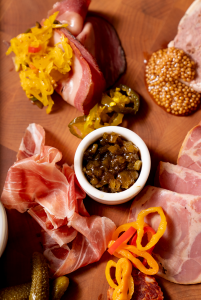Most people hear the term food waste and think of HyVee’s Misfit produce section, or backyard compost piles. But what if we told you that you could cut down on food waste by eating more soup, sausage and salami?
It’s true — you can help cut back on landfill buildup and fill up your stomach at the same time.
When animals, such as cows and pigs, are butchered, there are parts that don’t have a high demand, including excess fat, skin, some of the tougher muscles and extremities. To many Americans, pig’s feet don’t sound too appetizing; but in reality, you probably eat them more often than you think if you’re a fan of soups and stocks. The same goes for animal fat and skin if you ever have a hankering for sausage gravy or a salami sandwich.
“You can’t have an abundance of something with nowhere for it to go,” according to CACC Instructor Brook Harlan. “That’s something I try to teach my students. Everything has to have a use.”

BOILING IT DOWN
When it comes to making undesirable cuts of meat palatable, low heat and time, along with technique and knowledge go a long way. “Muscles that are used a lot aren’t naturally tender,” Harlan says. “You can grill a porkchop, but if you take a shoulder or chuck and grill it, you would be gnawing forever. It used to be that people without a lot of money would purchase the less tender parts, but now it’s considered cool to eat those parts because they have more flavor.”
In case you don’t want to be gnawing forever, Harlan has a few tips. Be sure to use moisture and a lower temperature for a longer time when you are cooking tougher parts of meat. Oftentimes, leftover cuts such as skin and feet are either boiled down into stock, or ground into sausage.
At the Culinary Center, Harlan has his students smoke leftover bones, meat and skin to make smoked pork stock — the basis of their famous gumbo.
FINDING A CURE
The other option for making unpalatable cuts more appealing is to break them up into smaller pieces. While sausage is one ground product, ultimately it can only be 10 to 20% fat, Harlan says, whereas cured sausage can have larger chunks of fat, making it a great way to utilize excess cuts.
And of course, one of the trending uses for cured sausage is as part of a charcuterie board. But, according to Ben Parks, Barred Owl Butcher & Table’s Owner/Chef/Chief Maintenance Engineer, it’s not just a recent Instagram trend. “Charcuterie has always been popular because not only was it a way to use stuff that was considered less desirable, but a lot of the techniques were for preservation,” he says. “Cuts like loin chops and tenderloins got used right away, but before refrigeration, they had to figure out a way to preserve the rest of the animal. A lot of charcuterie processes originated from that salting, drying and smoking preservation techniques.
“Whether or not people realize it, it’s always been popular in American cuisine. Smoked meats are charcuterie. Hot dogs and bacon are charcuterie. In the 21st century, there’s been this resurgence of old-world charcuterie in terms of salamis and things like that,” Parks continues.
Harlan pinpoints that resurgence of traditional charcuterie in part to the release of a book in 2005. “This book came out that every chef I knew with a restaurant bought,” Harlan says. The title? Charcuterie: The Craft of Salting, Smoking and Curing by Brian Polcyn and Michael Ruhlman. “It was so interesting to see how within a couple years, all of these restaurants started doing sausages and more charcuterie.”

Of course, charcuterie means more than a slice of salami. In fact, it’s a lot of different things, Harlan says. “It’s the art of curing, smoking and preserving meats but that also goes with the accompaniments, mustards, relishes, pickles, things like that you make to go along with the meats. Charcuterie is an experience and I think you can have an array of different things to showcase that you didn’t have to make all that day. Some of those pieces have taken months if not years to get where they are now.”
Parks knows firsthand how long curing can take. “It’s directly proportional to how big of a piece of meat you’re doing and what you want the final product to be,” he says. For bacon, it takes a week or two to cure the pork belly, then it gets smoked, sliced and served. Step up to a salami — essentially a sausage that is dried and cured — and you’re looking at anywhere from a few months to a year. Of course, an even bigger cut of meat, such as a whole muscle, takes much longer. For example, prosciutto can take anywhere from one to five years to cure.
BEST PRACTICES
Although every animal has parts that aren’t always used, there are a few that lend themselves more to tail-to-snout cooking than others. Harlan and Parks agree that beef, pork and duck are three that make the cut.
“10 years ago, Mike Odette, one of the founders of Sycamore, told me that duck was the new pig,” Harlan says. “You can make duck confit with their legs and because all of the meat is red meat, versus with chickens it’s dark versus light meat, it’s all very flavorful and has more fat.” In the past, Harlan says, people would make confit with duck legs because it was able to be stored without refrigeration. The fat layer on the top kept the broth and legs underneath from spoiling — plus, it was delicious. “Waterfowl has a very different meat texture, and ducks are cleaner from the standpoint of how they’re raised.”
Parks says that for American and Western European charcuterie, pork is a must-have. However, he continues, “no matter what region of the world you’re in, you’ll find people making some sort of charcuterie out of whatever meat they have available.” This includes jerkies, smoked and salted meats, and in coastal regions, smoked and cured fish.
Board Basics
Looking to make your own flawless charcuterie board? Veronica Everly, owner of Veronica’s Vittles, has a few tips:

- Arrange category by category. I like to put my cheeses on first, then any small bowls (empty), then the meats. Once I like the composition, I’ll add the sauces, olives, pickles, jams, honey, etc. to the bowls (this way they don’t accidentally spill during arranging). Next, I add the fresh fruit and vegetables, then fill any holes with the smaller items like nuts, chocolates and dried fruits. I’ll add the herbs last as the finishing touch.
- Buying a salami whole (8oz) is significantly less expensive than pre-sliced. If you know you will want to serve it thinly sliced, you can ask the deli to slice it for you to save time — and your fingers!
- Salty potato chips make an unexpected, but delicious cracker!
Some Company
While salami on its own is certainly delicious, what makes a charcuterie board truly enjoyable is the addition of accompaniments. According to Parks and Harlan mustards, jams, jellies and pickled vegetables are easy accompaniments that anyone can make at home. As a twist on traditional pickles, Parks recommends pickling carrots, cauliflower or green beans for a unique addition.
Country Mustard Recipe
By Brook Harlan
½ cup mustard seeds (yellow, brown, or mixed), crush with the bottom of a pan on a cutting board
½ cup white wine vinegar
¼ cup white wine
2 tablespoons sugar
¼ cup water and more as needed
Pinch salt
Bring vinegar, wine, water, sugar and salt to a boil. Add mustard seeds and bring the mixture back to a boil. Adjust with more water as needed. Turn off heat and let cool for an hour. Place into a container and refrigerate overnight. Once cool, season with more salt as need and adjust consistency with water as needed. To sweeten, add dissolved sugar (in the form of simple syrup, honey, agave, corn syrup, molasses, sorghum or maple syrup, depending on the desired flavor). This mustard will keep in the refrigerator for 1 to 2 weeks.
Variations
- You can use mustard powder instead of seeds for a smoother end product. Just don’t bring the mixture back to a boil after you add the powder.
- To create pickled mustard seeds, use whole seeds instead of crushed.

Fig Mostarda Recipe
By Brook Harlan
1 cup dried figs, stems removed and chopped
1 small onion, diced
2 tablespoons butter
½ sugar
1 cup white wine
¼ cup balsamic vinegar
½ cup water, more as needed
1 tablespoon mustard powder
Pinch ginger
½ teaspoon salt
Cut figs and onion and sauté over medium heat in butter until onions start to soften and the edges start to brown. Add all other ingredients and bring to a simmer. Turn off the burner and let cool slightly. Taste and adjust seasoning (mostly salt and sugar) as needed. Once fully cool, flavors will be much more subdued. While warm, the compote should taste almost too sweet and just under being salty. You can keep large chunks as it, or transfer to a food processer while warm and pulse to the desired consistency. Transfer to a container and refrigerate. Will keep in the refrigerator for 1 to 2 weeks.
Variations
- You can replace half of the mustard powder with seeds for a more textured mostarda.
- Try replacing the white sugar with brown sugar, coconut sugar, etc. for different flavor profiles.
- Swap out the white wine with red wine for a richer taste.


